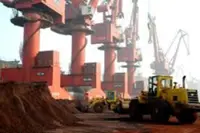Slow progress: A file photo of a wind farm off New York. The Biden administration approved the seventh large offshore wind project in the United States in March. — AP
New York: President Joe Biden’s landmark climate law has mobilised hundreds of billions of US dollars in federal and private capital for clean energy.
Yet, panelists at BloombergNEF’s summit in New York said money alone won’t supercharge the transition from fossil fuels.
While the United States spent US$303bil on the energy transition last year – thanks in part to generous tax credits and incentives in Biden’s Inflation Reduction Act (IRA) – the country has failed to reach its full decarbonisation potential.
Attendees pointed to permitting bottlenecks, connection delays and trade issues as hindrances slowing the greening of electric power grids.
“You can throw all the money you want in the world, but if you can’t get the steel in the ground, that’s an issue,” said Pedro Pizarro, chief executive officer of California utility giant Edison International, during a panel discussion.
Executives at the two-day summit were enthusiastic about carbon-cutting technologies’ growth even as they agreed that the process to permit remains a major bottleneck.
Lining up all the paperwork for a big transmission project often takes 12 years, far longer than the three years it typically takes to build it.
There are talks in Washington to streamline the permitting process. Pizarro suggested that regulators avoid duplicating some reviews and added that agencies need more resources to pore through voluminous stacks of applications.
There’s a similar dynamic at play with US solar manufacturing: Economic, policy and other headwinds are limiting the reach of the IRA’s subsidies.
While the law is driving “massive” plans to expand domestic solar making, there’s a gap between new factory announcements and what’s actually being built, said Art Fletcher, the head of domestic content for Invenergy LLC.
The firm is a big clean-power developer that just started producing panels in a joint venture with Longi Green Energy Technology Co in Ohio.
“It’s pretty darn hard to build a factory and to make it competitive with everything that’s going on,” he said.
The IRA has effectively introduced a contradiction to the US solar industry. On the one hand, it has unleashed more investments in the solar supply chain over the last two years than the previous 20, said Scott Moskowitz, senior director of market strategy and industry relations for QCells North America.
But on the other, manufacturers are confronting demand challenges, including a shrinking domestic residential market and high interest rates that have slowed projects big and small.
Uncertainty around trade and federal policy can undermine investments in the supply chain by heightening borrowing costs and deterring investment, said Nigel Cockroft, JinkoSolar’s US general manager.
Solar as a fuel may be free, “but the plants have to be built with borrowed money” – and “that money has competition”.
After a challenging year of inflation and cancelled offshore wind projects, there are signs the US sector is adjusting to a new normal.
“This was a black swan event – or possibly multiple black swan events – on top of each other,” Doreen Harris, head of the New York State Energy Research and Development Authority, said of the previous year.
In an effort to ensure it doesn’t see a repeat of last year’s cancelled projects, Orsted has slowed its developments, according to David Hardy, its Americas head.
The Danish company is now taking more time before it makes final investment decisions on projects to try and incorporate inflation and supply chain kinks into its planning.
Previously, the company had rushed forward and invested heavily because federal and state governments and set ambitious targets for offshore wind.
“Sometimes when you’re a bold mover it works out, and sometimes it doesn’t,” Hardy said.
The IRA has also helped spur interest in technologies such as green hydrogen and carbon capture.
Yet these moonshot technologies have yet to prove their usefulness at a meaningful scale.
For startups to thrive, they will need to take stock of product-market fit. They will have to access cheap or waste feedstock as well as strategic locations.
And they will need binding offtake agreements, according to Claire Curry, BNEF’s head of technology, industry and innovation. — Bloomberg





